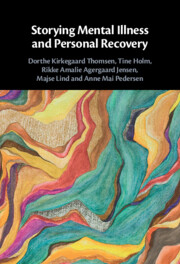Book contents
- Storying Mental Illness and Personal Recovery
- Storying Mental Illness and Personal Recovery
- Copyright page
- Contents
- Figures
- Tables
- Acknowledgments
- Chapter 1 Introducing the Book
- Chapter 2 The Science of Mental Illness
- Chapter 3 Vulnerability, Stress, and Burden in Mental Illness
- Chapter 4 Recovery and Mental Illness
- Chapter 5 Narrative Identity
- Chapter 6 Narrative Identity, Illness, and Well-Being
- Chapter 7 How Did We Collect and Analyze the Life Stories?
- Chapter 8 Overview of Narrative Identity Themes from the Initial Analyses
- Chapter 9 Relationship Themes in Narrative Identity
- Chapter 10 Self Themes in Narrative Identity
- Chapter 11 Functional-Level Themes in Narrative Identity
- Chapter 12 Treatment Themes in Narrative Identity
- Chapter 13 Summary and Synthesis
- Chapter 14 Understanding the Interplay between Narrative Identity and Mental Illness: A Framework
- Chapter 15 Tools for Narrative Repair
- Conclusion
- Book part
- References
- Index
Chapter 15 - Tools for Narrative Repair
Published online by Cambridge University Press: 02 February 2023
- Storying Mental Illness and Personal Recovery
- Storying Mental Illness and Personal Recovery
- Copyright page
- Contents
- Figures
- Tables
- Acknowledgments
- Chapter 1 Introducing the Book
- Chapter 2 The Science of Mental Illness
- Chapter 3 Vulnerability, Stress, and Burden in Mental Illness
- Chapter 4 Recovery and Mental Illness
- Chapter 5 Narrative Identity
- Chapter 6 Narrative Identity, Illness, and Well-Being
- Chapter 7 How Did We Collect and Analyze the Life Stories?
- Chapter 8 Overview of Narrative Identity Themes from the Initial Analyses
- Chapter 9 Relationship Themes in Narrative Identity
- Chapter 10 Self Themes in Narrative Identity
- Chapter 11 Functional-Level Themes in Narrative Identity
- Chapter 12 Treatment Themes in Narrative Identity
- Chapter 13 Summary and Synthesis
- Chapter 14 Understanding the Interplay between Narrative Identity and Mental Illness: A Framework
- Chapter 15 Tools for Narrative Repair
- Conclusion
- Book part
- References
- Index
Summary
In Chapter 15, we described our guide for narrative repair, an intervention developed to explore identity problems arising from mental illness and identity resources for pursuing a good life. The guide is a flexible tool that can be employed as self-help, as structured conversation with close others, and as a therapeutic intervention. The first task includes creating an overview of the life story to be employed as a platform for the other tasks and for identifying potential obstacles to narrative repair. The second task aims to explore and support coping with identity problems arising from mental illness (e.g., fear of the ill self, the negative self, and loss of previous selves). The third task focuses on exploring and reviving the agentic, growing, accepting, and valued selves and bringing them into everyday life. The fourth task consists of constructing a hopeful and realistic future story as well as considering potential routes to reach this recovering self. We suggest that vicarious stories of recovery shared by peer workers may scaffold personal recovery stories. Finally, we discuss how healthcare professionals engaging in narrative repair may deepen their empathy and gain hope by holding on to recovery stories.
- Type
- Chapter
- Information
- Storying Mental Illness and Personal Recovery , pp. 198 - 228Publisher: Cambridge University PressPrint publication year: 2023



